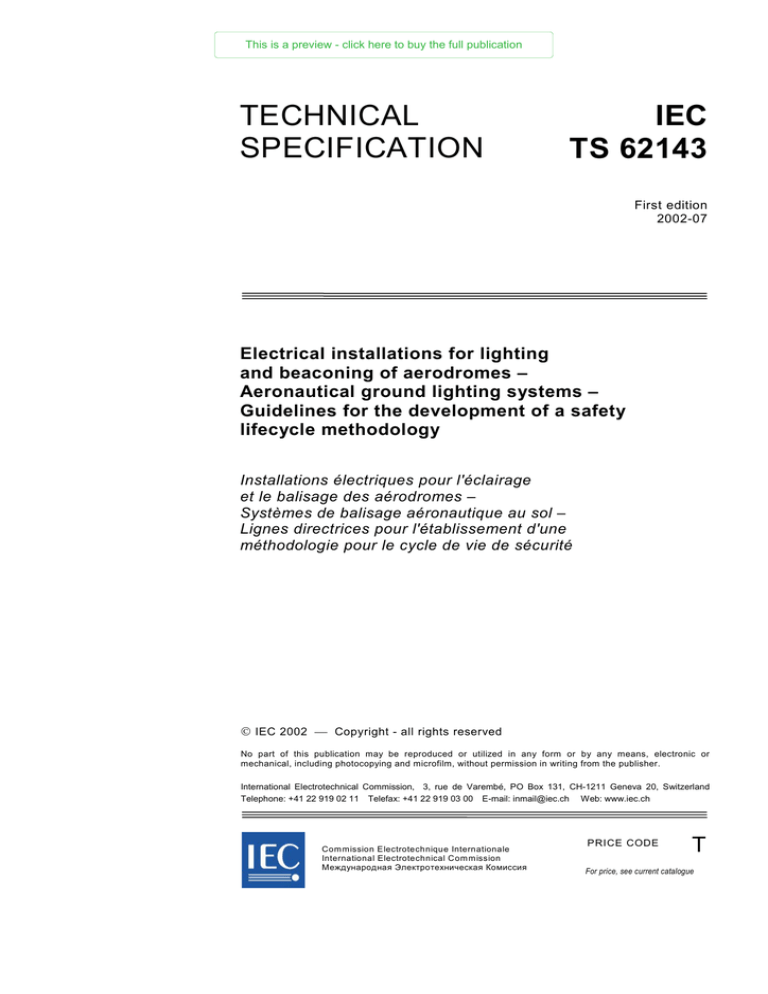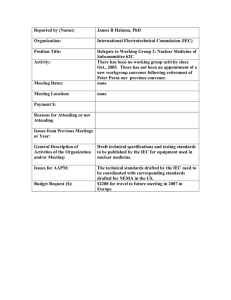
This is a preview - click here to buy the full publication
TECHNICAL
SPECIFICATION
IEC
TS 62143
First edition
2002-07
Electrical installations for lighting
and beaconing of aerodromes –
Aeronautical ground lighting systems –
Guidelines for the development of a safety
lifecycle methodology
Installations électriques pour l'éclairage
et le balisage des aérodromes –
Systèmes de balisage aéronautique au sol –
Lignes directrices pour l'établissement d'une
méthodologie pour le cycle de vie de sécurité
IEC 2002 Copyright - all rights reserved
No part of this publication may be reproduced or utilized in any form or by any means, electronic or
mechanical, including photocopying and microfilm, without permission in writing from the publisher.
International Electrotechnical Commission, 3, rue de Varembé, PO Box 131, CH-1211 Geneva 20, Switzerland
Telephone: +41 22 919 02 11 Telefax: +41 22 919 03 00 E-mail: inmail@iec.ch Web: www.iec.ch
Com mission Electrotechnique Internationale
International Electrotechnical Com m ission
Международная Электротехническая Комиссия
PRICE CODE
T
For price, see current catalogue
This is a preview - click here to buy the full publication
–2–
TS 62143 IEC:2002(E)
CONTENTS
FOREWORD .......................................................................................................................... 3
INTRODUCTION .................................................................................................................... 5
1
Scope .............................................................................................................................. 6
2
Normative references ....................................................................................................... 6
3
Definitions........................................................................................................................ 7
4
Competence of persons ................................................................................................... 8
5
4.1 Objective ................................................................................................................ 8
4.2 Requirements ......................................................................................................... 8
AGL safety management .................................................................................................. 8
6
5.1
5.2
5.3
5.4
5.5
5.6
AGL
7
6.1 Objectives..............................................................................................................13
6.2 Requirements ........................................................................................................13
AGL system safety lifecycle phases in detail ....................................................................15
7.1
7.2
7.3
7.4
7.5
7.6
7.7
7.8
Objective ................................................................................................................ 8
Documentation........................................................................................................ 9
AGL safety plan ...................................................................................................... 9
AGL safety assessment plan ..................................................................................11
Verification plan .....................................................................................................12
AGL safety case.....................................................................................................12
system safety lifecycle .............................................................................................13
Evaluation..............................................................................................................16
Technical solutions ................................................................................................17
Realisation.............................................................................................................18
Planning ................................................................................................................19
Installation .............................................................................................................20
Commissioning ......................................................................................................21
Operations .............................................................................................................21
Decommissioning...................................................................................................22
Bibliography ..........................................................................................................................25
Figure 1 – AGL system safety lifecycle...................................................................................15
Table 1 – Summary of the AGL System Lifecycle Requirements .............................................23
This is a preview - click here to buy the full publication
TS 62143 © IEC:2002(E)
–3–
INTERNATIONAL ELECTROTECHNICAL COMMISSION
____________
ELECTRICAL INSTALLATIONS FOR LIGHTING
AND BEACONING OF AERODROMES –
AERONAUTICAL GROUND LIGHTING SYSTEMS –
GUIDELINES FOR THE DEVELOPMENT OF
A SAFETY LIFECYCLE METHODOLOGY
FOREWORD
1) The IEC (International Electrotechnical Commission) is a worldwide organization for standardization comprising
all national electrotechnical committees (IEC National Committees). The object of the IEC is to promote
international co-operation on all questions concerning standardization in the electrical and electronic fields. To
this end and in addition to other activities, the IEC publishes International Standards. Their preparation is
entrusted to technical committees; any IEC National Committee interested in the subject dealt with may
participate in this preparatory work. International, governmental and non-governmental organizations liaising
with the IEC also participate in this preparation. The IEC collaborates closely with the International Organization
for Standardization (ISO) in accordance with conditions determined by agreement between the two
organizations.
2) The formal decisions or agreements of the IEC on technical matters express, as nearly as possible, an
international consensus of opinion on the relevant subjects since each technical committee has representation
from all interested National Committees.
3) The documents produced have the form of recommendations for international use and are published in the form
of standards, technical specifications, technical reports or guides and they are accepted by the National
Committees in that sense.
4) In order to promote international unification, IEC National Committees undertake to apply IEC International
Standards transparently to the maximum extent possible in their national and regional standards. Any
divergence between the IEC Standard and the corresponding national or regional standard shall be clearly
indicated in the latter.
5) The IEC provides no marking procedure to indicate its approval and cannot be rendered responsible for any
equipment declared to be in conformity with one of its standards.
6) Attention is drawn to the possibility that some of the elements of this technical specification may be the subject
of patent rights. The IEC shall not be held responsible for identifying any or all such patent rights.
The main task of IEC technical committees is to prepare International Standards. In
exceptional circumstances, a technical committee may propose the publication of a technical
specification when
•
the required support cannot be obtained for the publication of an International Standard,
despite repeated efforts, or
•
the subject is still under technical development or where, for any other reason, there is the
future but no immediate possibility of an agreement on an International Standard.
Technical specifications are subject to review within three years of publication to decide
whether they can be transformed into International Standards.
IEC 62143, which is a technical specification, has been prepared by IEC technical committee 97:
Electrical installations for the lighting and beaconing of aerodromes.
The text of this technical specification is based on the following documents:
Enquiry draft
Report on voting
97/72/CDV
97/83/RVC
Full information on the voting for the approval of this technical specification can be found in the
report on voting indicated in the above table.
This publication has been drafted in accordance with the ISO/IEC Directives, Part 3.
This is a preview - click here to buy the full publication
–4–
TS 62143 IEC:2002(E)
The committee has decided that the contents of this publication will remain unchanged until
2005-11. At this date, the publication will be
•
•
•
reconfirmed;
withdrawn, or
replaced by an international standard.
This is a preview - click here to buy the full publication
TS 62143 © IEC:2002(E)
–5–
INTRODUCTION
Aeronautical ground lighting (AGL) at an aerodrome or heliport provides the pilots of aircraft on
approach to or take-off from an aerodrome, and pilots of aircraft or drivers of vehicles moving
on the aerodrome surface, with location, orientation and alignment information. An AGL system
therefore provides a safety-related service and functions. In order to assure that the safety of
the service and functions provided by the AGL system is adequately addressed, specific safety
assessments should be performed at various instances during the lifecycle of the system. This
technical specification provides a methodology whereby this may be done.
This technical specification is primarily concerned with the safety lifecycle of aeronautical
ground lighting (AGL) systems. To conform to this technical specification it should be
demonstrated to the relevant bodies that the requirements have been satisfied and therefore
that the clause objective(s) has been met.
NOTE 1
Examples of relevant bodies would include the following:
•
aerodrome management;
•
certification and licensing authorities;
•
safety regulators;
•
notified bodies for international or European directives;
•
national standards bodies.
NOTE 2 This technical specification is based on the system and safety lifecycle methodology described in
IEC 61508-1. IEC 61508, in all seven parts, provides a methodology to address the safety of safety-related systems
and contains an abundance of guidance material, which may be applicable to an AGL system or may be of use to
the reader of this technical specification. IEC 61508 contains requirements that are particularly relevant to risk
reduction in a software-based AGL system.
This is a preview - click here to buy the full publication
–6–
TS 62143 IEC:2002(E)
ELECTRICAL INSTALLATIONS FOR LIGHTING
AND BEACONING OF AERODROMES –
AERONAUTICAL GROUND LIGHTING SYSTEMS –
GUIDELINES FOR THE DEVELOPMENT OF
A SAFETY LIFECYCLE METHODOLOGY
1
Scope
This technical specification:
−
outlines a methodology to address the safety at all lifecycle phases of an AGL system,
including the evaluation, design, procurement, manufacture, installation, commissioning,
operational use, maintenance, modification, and decommissioning of the AGL system;
NOTE 1 This document contains guidelines of a high-level, objective-based, and non-prescriptive nature. This
is intended to permit a flexible approach to meeting the requirements.
−
applies to an AGL system at an aerodrome or heliport which provides visual guidance to a
pilot and is provided, operated and maintained by the aerodrome authority;
NOTE 2 This document may apply to all or a part of an AGL system as required by the aerodrome authority.
The equipment covered shall be defined and listed in the AGL safety case (see 5.6). Any subsequent addition
or modification to the AGL system shall be notified as directed in 7.7.3.
−
applies primarily to a new AGL system;
NOTE It may also be applied to an existing AGL system or to an existing AGL system that is being modified;
however, the relevant documentation for the project phases may not be available. Therefore, retrospective
action to cover the applicable lifecycle phases could be carried out or alternative means of providing safety
information should be developed, e.g. historical data.
−
covers all aspects of safety, including:
•
operational (functional) safety of the AGL system;
•
electrical safety for the installation, maintenance and decommissioning of the AGL
system;
•
environmental safety and electromagnetic compatibility (EMC);
•
health and safety at work.
−
supports a regulatory regime based on the auditing of a safety management system at an
aerodrome, where the safety management system provides documented evidence that
safety has been or is being addressed at all phases of the lifecycle. This applies equally to
a project to install AGL or the routine operational use and maintenance of the AGL.
2
Normative references
The following referenced documents are indispensable for the application of this document. For
dated references, only the edition cited applies. For undated references, the latest edition of
the referenced document (including any amendments) applies.
IEC 60300-3-9, Dependability management – Part 3: Application guide – Section 9: Risk
analysis of technological systems
IEC 61508 (all parts), Functional safety of electrical/electronic/programmable electronic safetyrelated systems
IEC 61508-1, Functional safety of electrical/electronic/programmable electronic safety-related
systems – Part 1: General requirements
This is a preview - click here to buy the full publication
TS 62143 © IEC:2002(E)
–7–
IEC 61508-7, Functional safety of electrical/electronic/programmable electronic safety-related
systems – Part 7: Overview of techniques and measures
IEC 61821, Electrical installations for lighting and beaconing of aerodromes – Maintenance of
aeronautical ground lighting constant current series circuits
3
Definitions
For the purpose of this International Standard the following definitions apply.
3.1
aerodrome authority
organisation accountable for the safety and security of persons, aircraft operations and
facilities at an aerodrome
3.2
AGL safety case
a controlled document, or set of controlled documents, which clearly and comprehensively
presents sufficient arguments, evidence and assumptions that all foreseeable hazards have
been identified and controlled for both engineering and operational areas to demonstrate that
an AGL system is adequately safe
3.3
AGL system safety lifecycle
the safety activities involved in the implementation of an AGL system, occurring during a period
of time that starts at the concept phase of the system and finishes when it is no longer
available for use and has been decommissioned
3.4
hazard
potential source of harm
NOTE The term includes hazards to persons arising within a short time scale (for example, fire and explosion) and
also those that have a long-term effect on a person’s health (for example, release of a toxic substance).
3.5
hazard analysis
activity of identifying and evaluating those hazards, often following from some initiating event,
that can lead to an accident
3.6
hazardous event
occurrence, with possible hazardous consequences, arising as the result of a hazardous
condition
3.7
impact analysis
activity of determining the effect that a change to a function or component in a system will have
on other functions or components in that system as well as on other systems.
3.8
safety audit
systematic and independent examination to determine whether the procedures specific to the
safety requirements comply with the planned arrangements, are implemented effectively and
are suitable to achieve the specified objectives
NOTE
A safety audit may be carried out as part of a safety assessment.
[61508-4, definition 3.8.4, modified]




